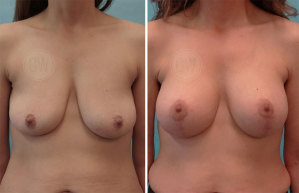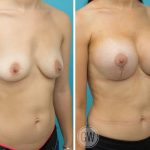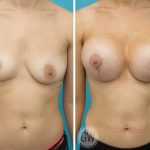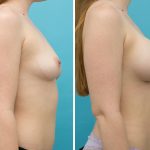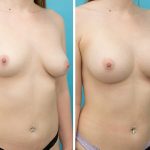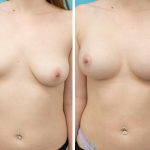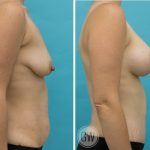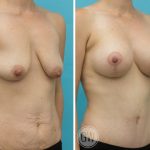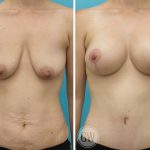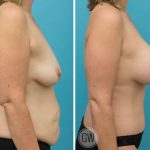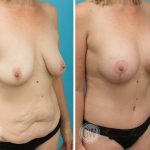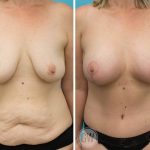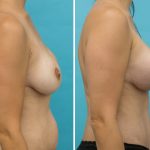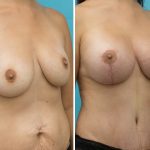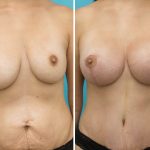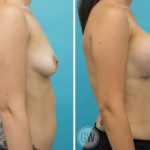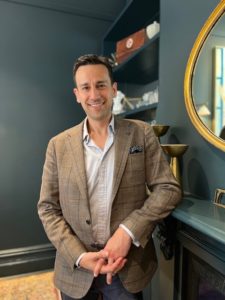This website contains imagery which is only suitable for audiences 18+.

Breast Lift (Mastopexy)
A Breast Lift, known as a Mastopexy, is a surgical procedure designed to remove excess skin and tissue whilst also lifting the breast higher on the chest wall. Over time, factors such as pregnancy, nursing/breastfeeding, weight fluctuations, ageing, and gravity can all take a toll on the shape and firmness of the breasts.
The procedure involves removing excess skin and tightening the surrounding tissue to reshape and support the altered breast contour. A Breast Lift can also reduce the size of the areola, which can become enlarged over time. It’s important to note that a Breast Lift does not significantly change the size of your breasts or add more volume in the upper pole (top of the breast). If you want your breasts to look fuller, you may need to consider Breast Lift Augmentation surgery with either implants or fat grafting.
Who Is a Good Candidate?
Suitable candidates for a Breast Lift are individuals who are in good physical health and maintain a stable weight. They should not smoke (or be willing to quit for an extended period of time both before and after surgery) and should have realistic expectations about the outcomes of the surgery.
You might be a suitable candidate for a Breast Lift if your breasts have lost shape and fullness. Without support, your nipples might sit below the crease of your breast. Your nipples and areolas may be oriented downwards. There could be stretched skin and enlarged areolas present. Additionally, one breast might be positioned lower than the other.
It’s important for candidates to understand that while a Breast Lift can be long-lasting, the results are not permanent. Pregnancy, weight fluctuations, the effects of gravity and ageing can all affect the outcomes of the surgery over time.
The type of incision will vary depending on the degree of lift required. The incision may be limited to just around the areolar, extend down the breast below the areolar (vertical lift) or may include an extension along the breast crease. Vertical techniques are used for the majority of Breast Lift procedures as this technique provides a balance between long lasting results, altered breast shape and scar reduction. The fundamental concept behind a Breast Lift is that it alters the shape, symmetry and contour of the breasts. Dr Watts and his team have many techniques available to help reduce the appearance and visibility of scars and will guide you through their postoperative protocol for scar management.
DOWNLOAD DR WATTS’ ULTIMATE GUIDE TO BREAST SURGERY
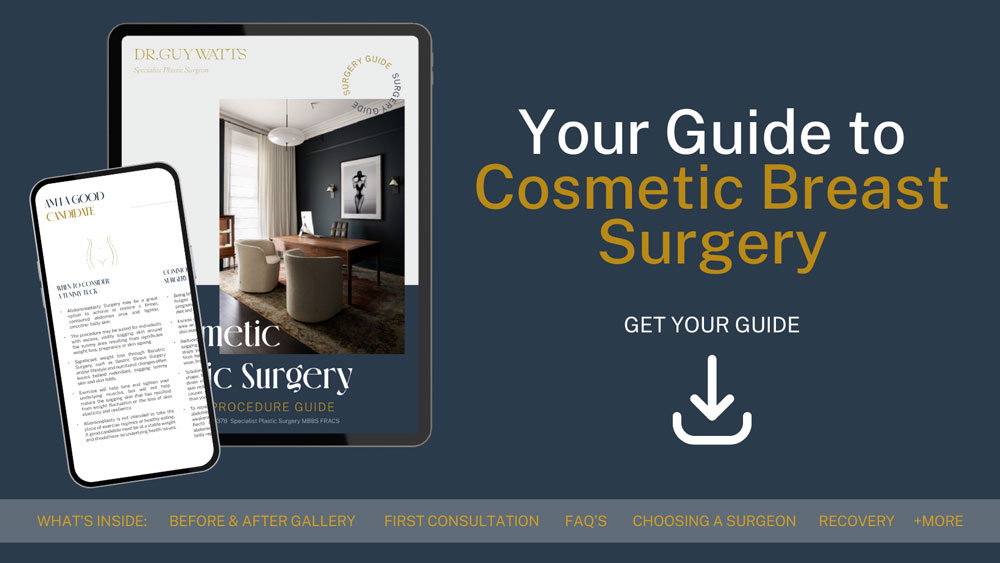
.
REQUEST AN APPOINTMENT
BREAST LIFT GALLERY
Before and after photos of Breast Lift Surgery patients by Dr Watts.
Photographs shown on this website are of actual patients who have given consent and permission to have their photos published. They are for illustrative purposes only and have not been manipulated in any way. Individual results may vary and depend on several factors including body type, skin health, genetics, recovery, lifestyle factors and more.
The images may contain nudity and are not intended for persons under the age of 18. Viewer discretion is advised.
WHAT CAN A BREAST LIFT DO FOR ME?
• Move breasts to a higher position on the chest wall
• Alleviate Breast ptosis (excess skin)
• Altered breast shape and contour
• Reposition the nipple
• Reduce areola size
• Reduce asymmetry
A Breast Lift may be done in conjunction with a Breast Augmentation or Reduction in some cases to optimise the results and meet patient desires however, this is up to the discretion of the surgeon and can be discussed during a consultation.
We recommend delaying Breast Lift procedures until there are no future plans for pregnancy. The long-term duration of the surgery will depend on a number of factors including lifestyle factors, age, skin health, genetics and breast size.
BREAST LIFT PROCEDURE AND RECOVERY PERIOD
How Is the Surgery Performed?
Breast Lift surgery is a complex procedure that takes two to three hours and is performed under general anaesthesia. The specific steps can vary depending on the degree of Lift required, the technique used and the patient’s individual anatomy, but the steps generally include:
- Incision: There are several incision patterns that can be used, including around the areola, vertically down from the areola to the breast crease, and horizontally along the breast crease. The choice of incision pattern depends on your specific conditions and desired results.
- Reshape the Breasts: Excess skin is removed, and the breast tissue is lifted and reshaped to change the breast contour and firmness. Dr. Watts may use fat grafting with the Breast Lift procedure to assist with reshaping the contour of the breasts.
- Reducing Areola Size: If the areolas are enlarged, they can be reduced by excising skin at the perimeter.
- Closing the Incisions: The incisions are closed with sutures, skin adhesives, or surgical tape. This not only reshapes the breast but also reduces excess skin.
- Seeing the Results: The results of a Breast Lift are immediately visible however, there will be bruising and swelling during the initial recovery. Over time, post-surgical swelling will subside, and incision lines will fade.
Dr. Watts performs Breast Lift surgery on an outpatient basis using general or twilight anaesthesia. The length of your procedure will depend on several factors but on average will take 2-3 hours to complete. Dressings will be placed over the breasts and a firm supportive bra applied. After the procedure you will be observed for a few hours to make sure your initial recovery is progressing well before you are allowed to return home with a friend or family member.
Written procedure specific information sheets will be given to you in order for you to prepare for your surgery and the recovery period. You may experience mild to moderate discomfort after the procedure, so a postoperative analgesia regime will be tailored to meet your specific needs. In general, you can expect bruising, swelling and tenderness of the breasts to settle within the first few weeks.
Recovery after Breast Lift Surgery
Recovery from a Breast Lift varies from person to person, but the general guideline is as follows:
- Post-Surgery Care: After the surgery, dressings will be applied to the incisions. You may be required to wear a support bra to reduce swelling and support the breasts as they heal.
- Managing Discomfort: Pain and discomfort are to be expected during recovery but can be managed with prescribed medication. It’s important to follow Dr. Watts instructions on how to care for your breasts post-surgery.
- Activity Restrictions: You’ll need to limit physical activity for at least the first two weeks after surgery. Avoid lifting heavy objects and strenuous exercise until Dr. Watts gives you the go ahead to resume these activities. This is generally around 6 weeks after the surgery.
- Follow-up Appointments: Regular follow-up appointments are necessary to monitor your healing. Dr. Watts will advise when you can return to normal activities and work.
- Long-term Care: The final results of your Breast Lift will appear over the next few months as breast shape and position continue to settle.
Dr Watts and his team are dedicated to providing ongoing care, support and guidance throughout your entire surgical experience. They will be readily available to answer any further questions you may have regarding surgery or recovery. For more information, please call our office to schedule a consultation with Dr Watts.
Breast Lift Risks
Plastic surgery comes with inherent risks. Patients must be aware of potential risks and potential complications and make informed decisions. Anaesthesia is used in most surgical procedures for patient safety and comfort. However, in rare cases, it can lead to complications such as allergic reactions, lung infections, stroke, and even heart complications.
Also, keep in mind that all surgeries result in some form of scarring. While Dr. Watts often uses techniques to reduce and strategically place these scars, some patients might experience hypertrophic or keloid scarring, which is raised and more prominent scar. It’s essential for anyone considering plastic surgery to thoroughly research and understand these risks. Read more about risks and potential complications of plastic surgery.
DOWNLOAD DR WATTS’ GUIDE TO COST OF SURGERY
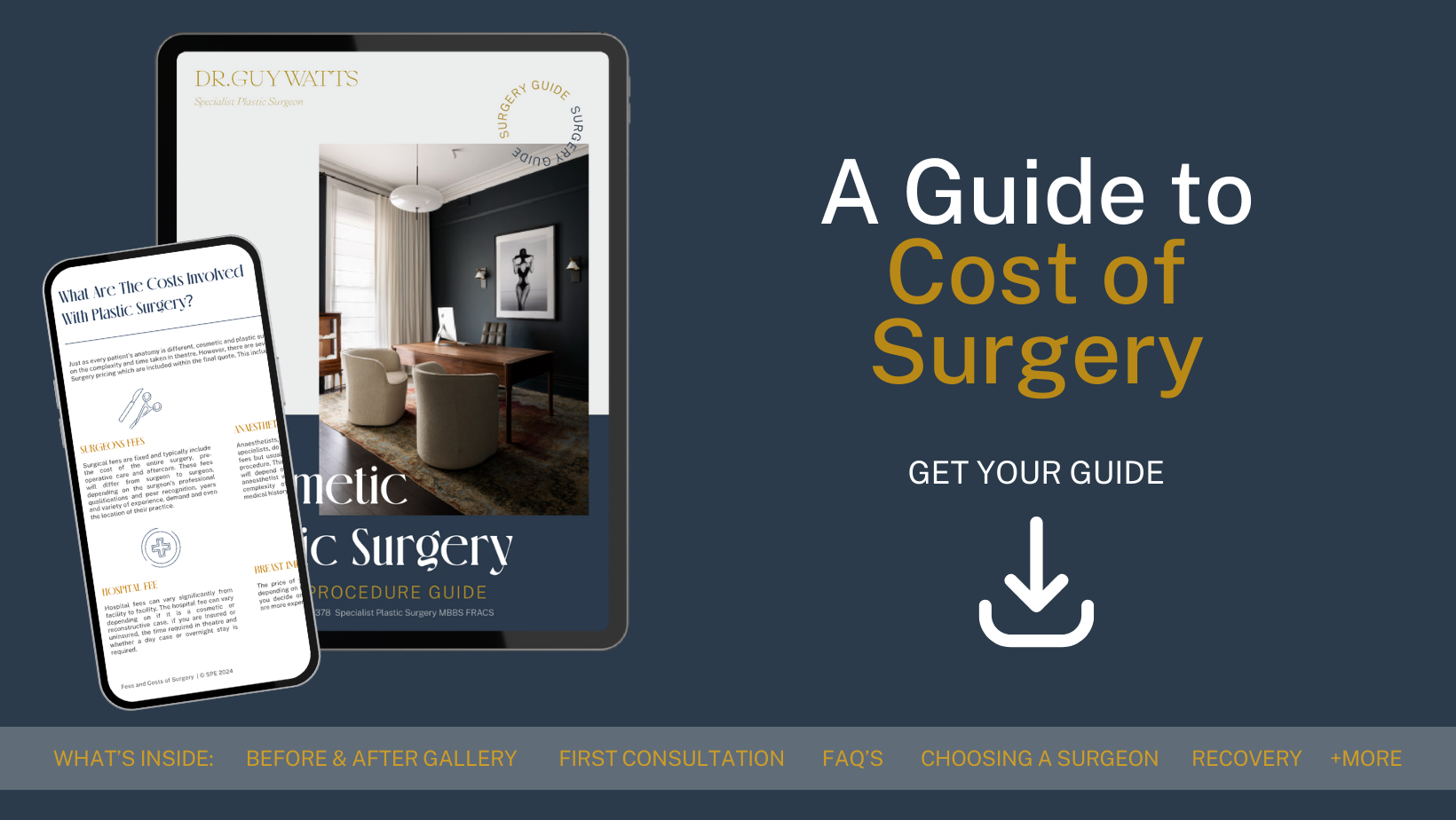
FAQs about Breast Lift Surgery
How long does it take to recover from a Breast Lift?
- Full recovery can take several weeks to months. Most patients can return to work and light activities within 2 weeks.
Will there be scars?
- Yes, there will be scars. The extent of scarring depends on the individual’s healing process and the surgical technique used. Scars will heal and fade over time but will never disappear.
Can I breastfeed after a Breast Lift?
- Breastfeeding may still be possible after a Breast Lift, but it depends on the surgical technique used and individual circumstances.
- If breastfeeding is something that you want to be able to do after a Breast Lift it is important to talk to Dr Watts about it during your consultation, before surgery.
What are the risks associated with a Breast Lift?
- As with any surgery, there are risks such as bleeding, infection, and adverse reactions to anaesthesia. Specific risks related to Breast Lift include changes in nipple or breast sensation and, in some cases, partial or total loss of the nipple or areola.
How do I know if I’m a good candidate for a Breast Lift?
- A consultation with a qualified plastic surgeon is the only way to determine if you’re a suitable candidate. Factors include physical health, breast size and shape, and your expectations.
Medical References about Breast Lift Surgery
Next Steps on Your Plastic Surgery Journey
PLEASE TAKE INTO CONSIDERATION
Any surgical or invasive procedure carries risks. Before proceeding, you should seek a second opinion from an appropriately qualified health practitioner.
About Dr. Guy Watts – MED0001539378
FRACS (Plas) – Specialist Plastic Surgeon In Perth WA
Dr. Guy Watts is a Specialist Plastic Surgeon (AHPRA MED0001539378) with an extensive career that spans across renowned plastic surgery clinics worldwide. His experience has been honed through invaluable experiences at esteemed establishments such as the New York Eye and Ear Infirmary and the renowned Pitanguy Clinic in Brazil.
Having collaborated with the foremost cosmetic plastic surgeons on a global scale, Dr. Watts has chosen to return to Perth after a 17-year journey of intensive training and invaluable professional experience to bring the latest practices and technology in cosmetic plastic surgery to his patients.
Dr. Watts is a Fellow of the Royal Australasian College of Surgeons (FRACS) and a Member of the Australian Society of Plastic Surgeons (ASPS), Australasian Society of Aesthetic Plastic Surgeons (ASAPS) and the International Society of Aesthetic Plastic Surgeons (ISAPS).
Read about the potential Risks and Complications of Surgery
Read the Patient Information and Resources
About CLINISPA
Clinispa is Dr Watts’ bespoke medical clinic performing Cosmetic Aesthetic treatments. At Clinispa, we offer advanced clinical treatments in a luxurious and calming environment, tailored to support your skin’s health and appearance.
Clinispa aesthetic services are performed by Dr Guy Watts’ nursing professionals, who have a passion for and solid understanding of facial aesthetics.
All Clinispa clients are considered individually, with a personalised treatment plan consisting of advanced scientific approaches to cosmetic aesthetics. We incorporate innovative technologies in conjunction with superiorly formulated skin care.
For more information about the full range of Clinispa Aesthetic of Cosmetic Treatments visit the Clinispa website
About Dr. Robert Owen
FRACS(Plas) – Specialist Plastic Surgeon In Perth WA
Dr Robert Owen is a Specialist Plastic Surgeon (AHPRA MED0001546983) consulting at Dr Watts clinic in Ventnor Ave, Perth. He performs Breast, Body, Face and Skin Cancer surgery.
After obtaining his Medical Degree in the UK, he moved to Perth in 2005 to work in some of Perth’s Hospitals.
He was awarded his Fellowship of the Royal Australasian College of Surgeons in 2018. Dr Rob travelled overseas in 2019/20 for an International Surgical Fellowship and advanced training,
Dr Robert has a broad background in cosmetic and reconstructive plastic surgery and has an exceptional commitment to patient care.
Dr. Owen is a Fellow of the Royal College of Surgeons (FRACS) and a Member of the Australian Society of Plastic Surgeons (ASPS),






